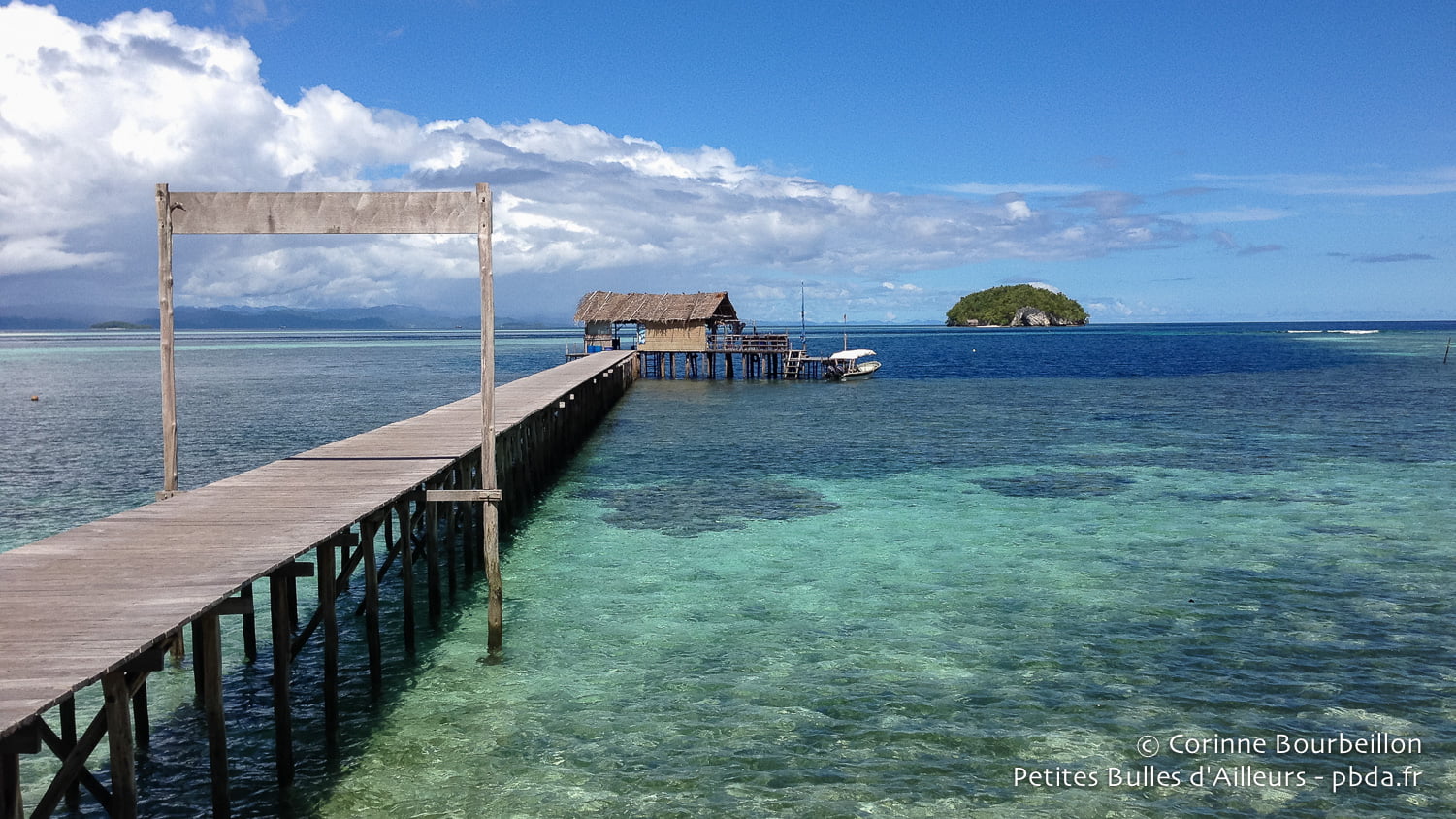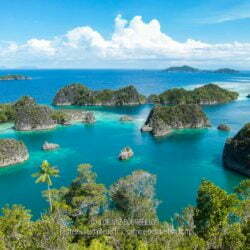Indonesia: Raja Ampat - January 2015
Dear English-speaking readers, this page is an automatic translation of an article originally written in French. I apologise for any strange sentences and funny mistakes that may have resulted. If you read French, click on the French flag below to access the original, correct text:
"Well? Tell us!" Telling Raja Ampat, not so simple. I have the feeling to come back from the end of the world. I don't know where to start...
Return to West Papua
Above, the spectacular "viewpoint" on the islets of Fam, emblematic of the landscapes of Raja Ampat... We see Otto, my great Papuan dive guide, and my partner Sarah.
Raja Ampat, these are crumbs of karst rock covered with primary forest in the middle of a sea of coral. It is an archipelago of Papua, governed by Indonesia. It is a (still) preserved nature (but for how long?) where the National Geographic comes to film sharks and manta rays. It is a paradise of biodiversity for divers eager for underwater wonders.
I just came back from there. This is my third trip there!
And I still can't get enough of it... 😍
Rennes-Sorong: a very long journey...
To reach the island of Kri, in Raja Ampat, I traveled 14 994 km exactly from Rennes, according to the website Tripline with which I drew the route below (click on Show Map). The end of the world.
In this month of January 2015, almost three years have passed, already, since my very first trip to Raja Ampat. The archipelago is located in West Papua, in the extreme east of Indonesia. I dream of going back there. It is there that I made the most beautiful dives of my life.
I fly a few days after the attacks against Charlie Hebdo and the Hyper Cacher at the Porte de Vincennes in Paris. After the horror, I have in my sights two weeks of vacation and carefree time.
This departure feels like a balm after these terrifying events. There is something soothing about contemplating the Earth from above, sliding across time zones in the night, leaving one world for another. The iPhone becomes a sensor of moments.
It's a long trip, then. It starts in Rennes station, with the TGV that takes me directly to Charles-de-Gaulle airport in Paris. About 3 hours of travel.
First aerial section : Paris-Jakarta via Dubai on Emirates Airlines. About 14 hours in the air and a short stopover in the middle. Upon arrival, I planned a night's rest near the Jakarta airport before taking off again the next day for Papua.
Second air route: Jakarta-Sorong via Makassar on Garuda Airlines. Nearly 6 hours in the air with a somewhat long stopover in the middle.
I arrive in Sorong at daybreak. There are only fifteen minutes of road to the pier and one hour and a half of crossing in a fast boat to reach my goal: the island of Kri.
I am often asked about the time spent in transportation... For this trip, from Rennes, it represents about 24 hours in total. With the stopovers and if we allow ourselves a night of rest, it takes not far from two days in total to reach Raja Ampat from Europe! But it is worth it.
During the crossing between Sorong and Kri, a school of dolphins crossed our path, like a happy omen. When the familiar triangle of Kri starts to appear on the horizon, I don't want to see it anymore!
I will find the island I have been dreaming of for so many months. I will see the pontoon of the Sorido Bay Resort and its incredible blue hole in the middle of the coral. And then, above all, this fabulous, extraordinary, unique profusion of life under water. Raja Ampat, finally!

Above, the island of Kri and the pontoon of the Sorido Bay Resort.
A little historical-political reminder: the western half of the immense New Guinea Island (formerly colonized by the Dutch) has been annexed by Indonesia in the 1960s (the eastern half became the independent state of Papua New Guinea). At that time, the Indonesian army committed massacres. Nowadays, a Papuan separatist movement continues to take action and the Indonesian authorities do not hesitate to brutally repress any opposition.
In March 2022The Indonesian government's bill to divide Papua into new provinces, without consulting the local population, has provoked a wave of protests, and Papuan protesters were killed by the police. Amnesty International has published a report denouncing the increased repression around the Wabu Block gold mine in the department of Intan Jaya (north central).
In April 2021, military reprisals were launched in the region of Puncak after the death of the head of the intelligence services during exchanges of fire with Papuan independence fighters.
In August 2019, violent riots broke out in Manokwari, Sorong and Fakfak, after the arrest of Papuan independence students in Java, against a backdrop of racist tensions: the government then cut off the internet in Papua and sent a thousand soldiers there as backup.
In July 2017almost twenty years after the Biak massacre (1998), the Indonesian military and police have carried out mass arrests in Nabire and Sentani, whilea petition for West Papua was attempting to bring the Papuan voice to the international stage that same year.
I close this parenthesis, but when you go there as a tourist, you have to be aware that the region is unstable and not quite a "paradise" for everyone...


































